Abstract
The records of the Phenylketonuria Register were examined to determine the factors associated with early intellectual progress in children who had received a diet low in phenylalanine from soon after birth. A total of 1031 children were born between 1964 and 1980 and started treatment before they were 4 months of age, and 808 of them were followed up prospectively. In 263 children born between 1964 and 1971 (cohort 1), the mean intelligence quotient (IQ) at 4 years rose with year of birth from 24 points below revised IQ norms to 10 points below; in 545 born between 1972 and 1980 (cohort 2) there was no further rise in IQ and the mean remained eight points below the norms. IQ fell progressively by roughly four points for each four weeks' delay in starting treatment, for each 300 mumol/l rise in mean phenylalanine concentrations during treatment, and for each five months during the first two years during which phenylalanine concentrations were below 120 mumol/l. Forty six children in cohort 2 had the most favourable treatment characteristics. Their mean IQ, after standardising for social class, was 112.6, and similar to the mean for the same group estimated by multiple regression, and to revised population IQ norms for the period during which the children were tested. The data suggest that many children who are treated early continue to suffer a mild degree of neurological impairment because of the difficulties in fully controlling the metabolic abnormality.
Full text
PDF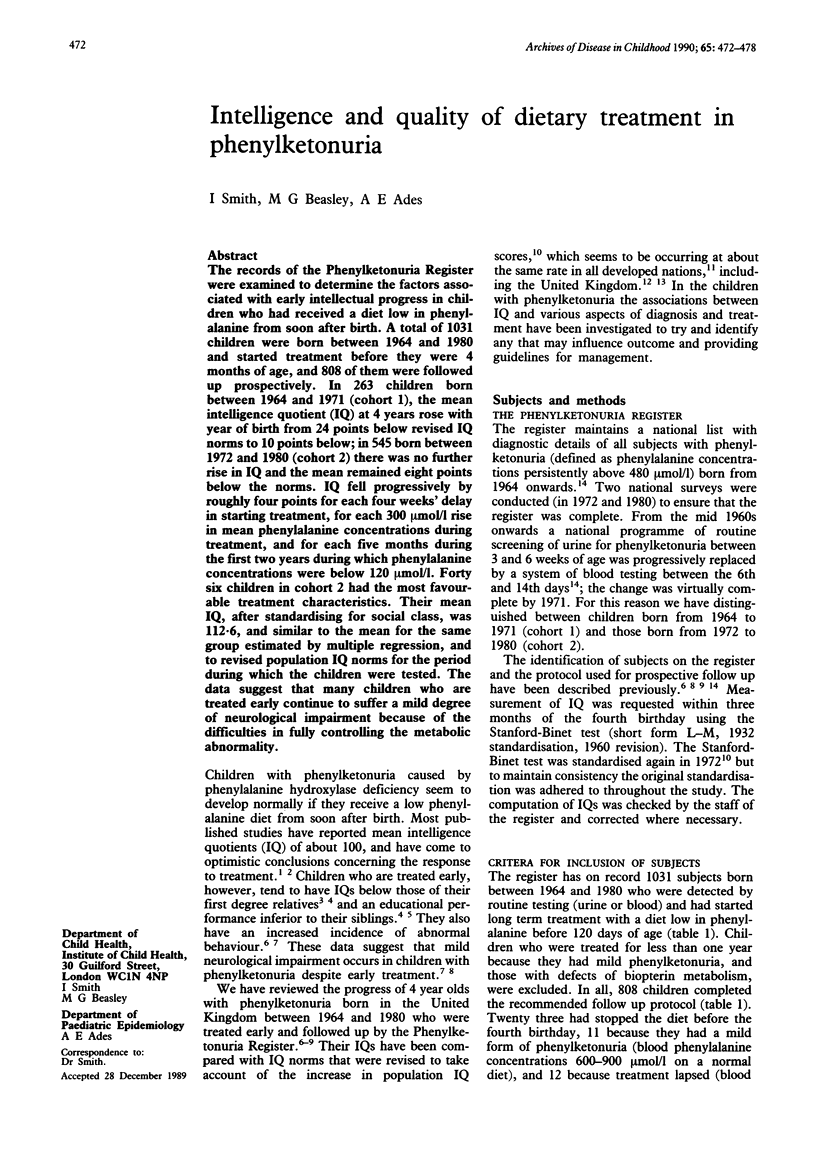
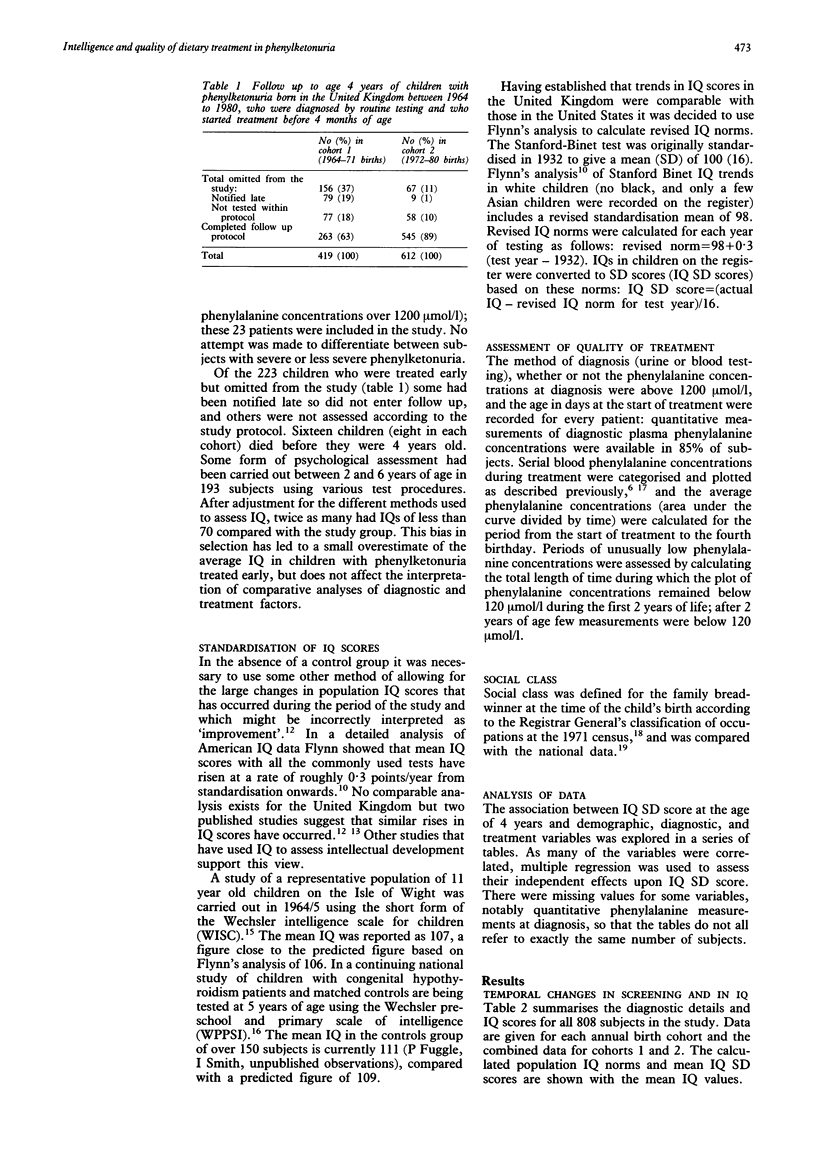
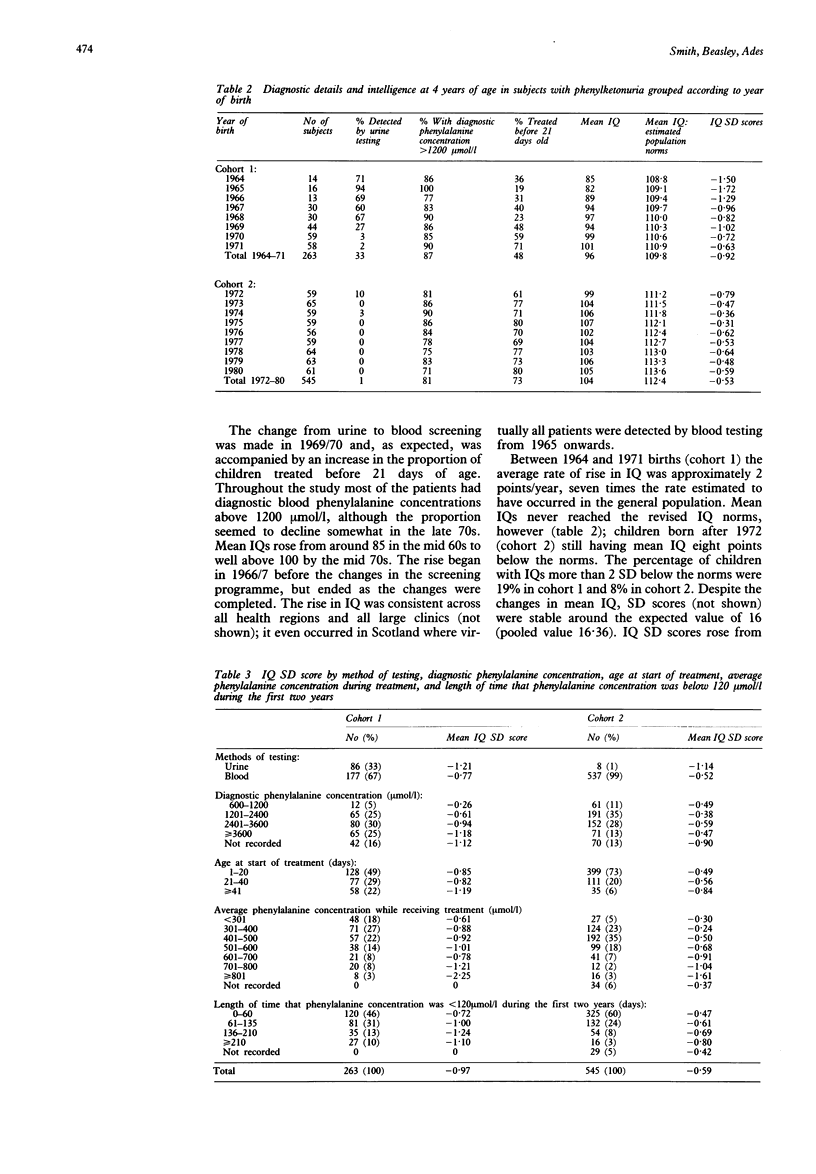

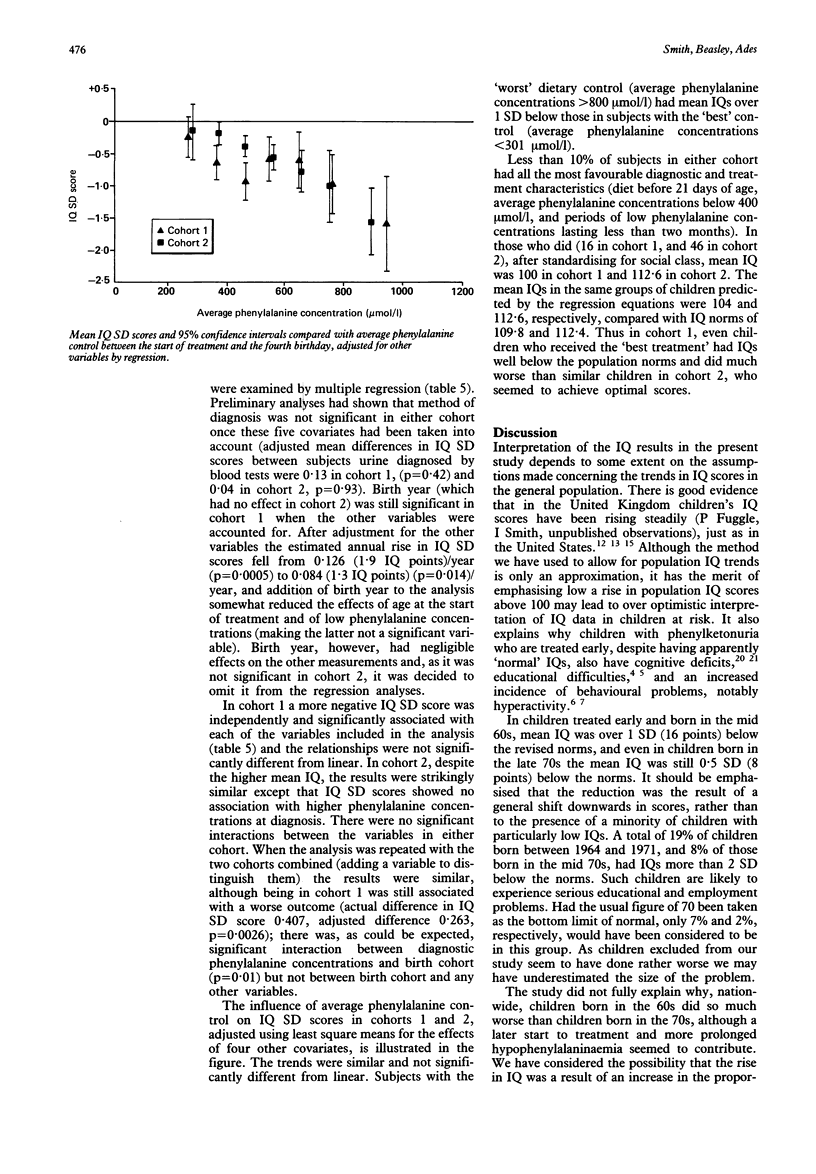
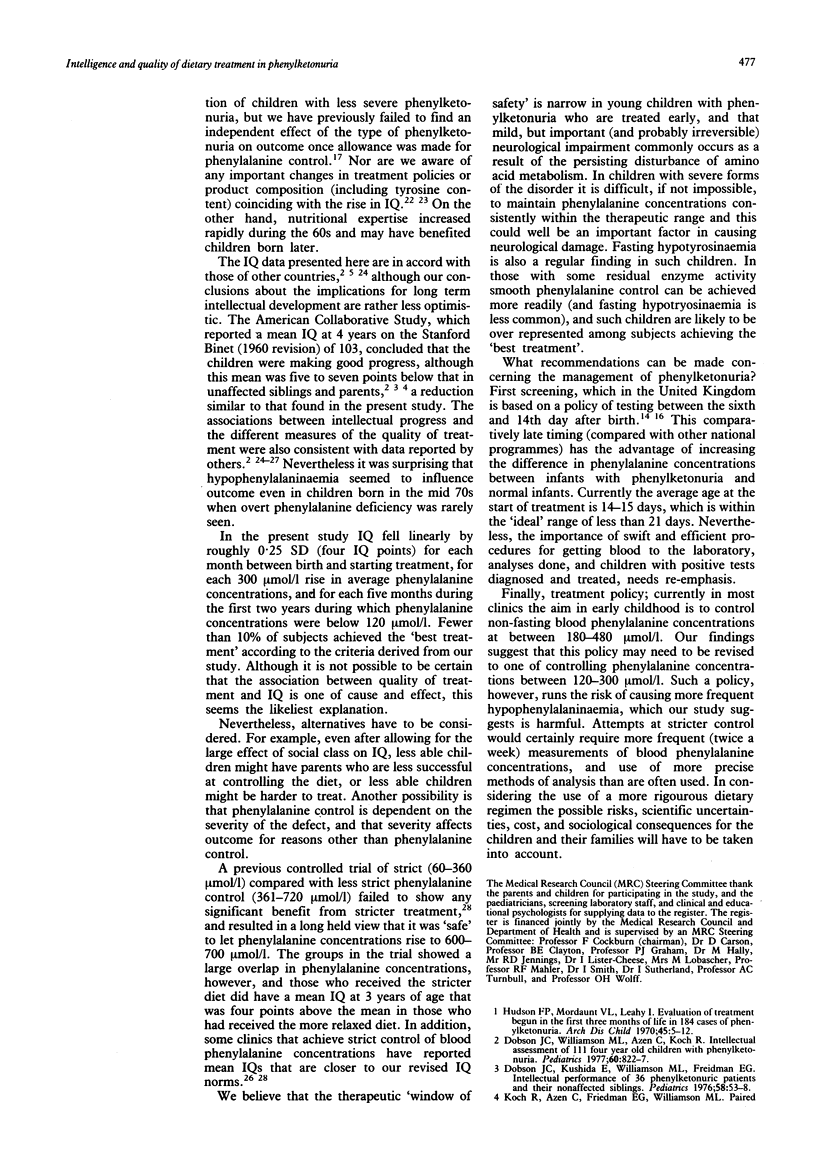
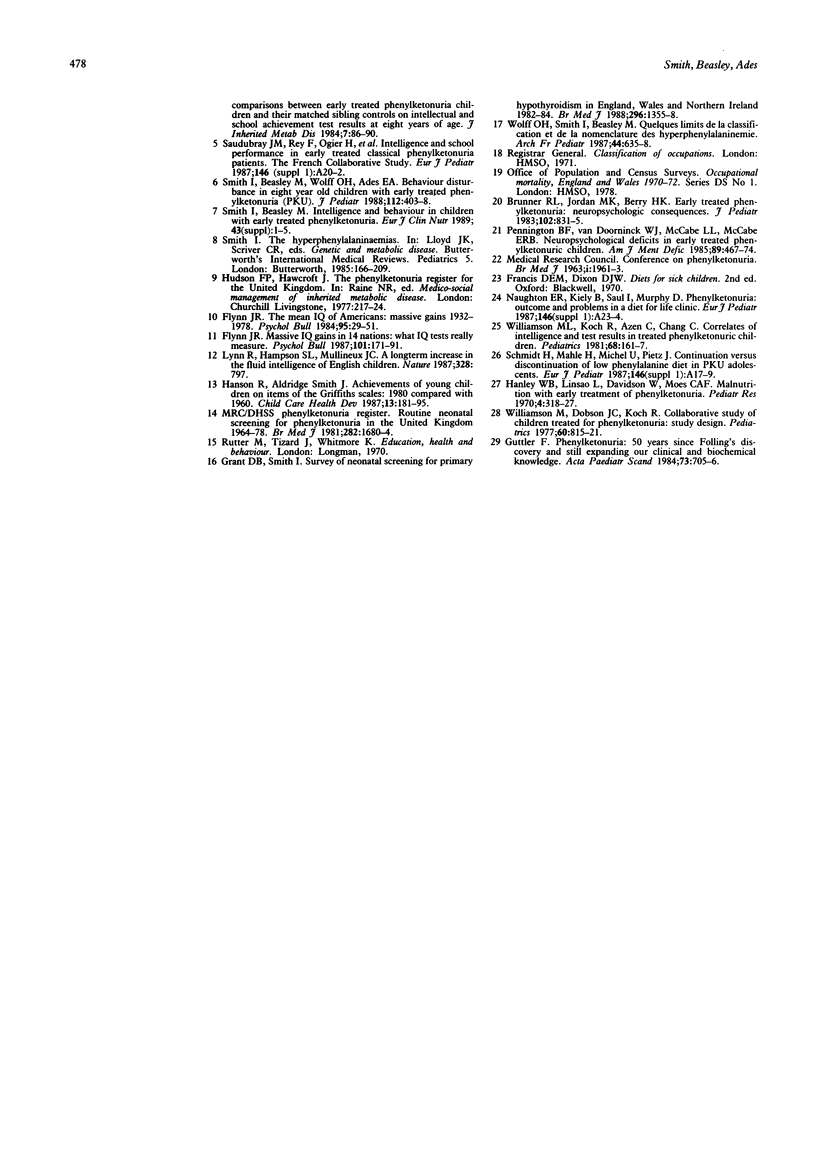
Selected References
These references are in PubMed. This may not be the complete list of references from this article.
- Brunner R. L., Jordan M. K., Berry H. K. Early-treated phenylketonuria: neuropsychologic consequences. J Pediatr. 1983 Jun;102(6):831–835. doi: 10.1016/s0022-3476(83)80007-9. [DOI] [PubMed] [Google Scholar]
- Dobson J. C., Kushida E., Williamson M., Friedman E. G. Intellectual performance of 36 phenylketonuria patients and their nonaffected siblings. Pediatrics. 1976 Jul;58(1):53–58. [PubMed] [Google Scholar]
- Dobson J. C., Williamson M. L., Azen C., Koch R. Intellectual assessment of 111 four-year-old children with phenylketonuria. Pediatrics. 1977 Dec;60(6):822–827. [PubMed] [Google Scholar]
- Grant D. B., Smith I. Survey of neonatal screening for primary hypothyroidism in England, Wales, and Northern Ireland 1982-4. Br Med J (Clin Res Ed) 1988 May 14;296(6633):1355–1358. doi: 10.1136/bmj.296.6633.1355. [DOI] [PMC free article] [PubMed] [Google Scholar]
- Güttler F. Phenylketonuria: 50 years since Følling's discovery and still expanding our clinical and biochemical knowledge. Acta Paediatr Scand. 1984 Nov;73(6):705–716. doi: 10.1111/j.1651-2227.1984.tb17763.x. [DOI] [PubMed] [Google Scholar]
- Hanley W. B., Linsao L., Davidson W., Moes C. A. Malnutrition with early treatment of phenylketonuria. Pediatr Res. 1970 Jul;4(4):318–327. doi: 10.1203/00006450-197007000-00002. [DOI] [PubMed] [Google Scholar]
- Hanson R., Smith J. A. Achievements of young children on items of the Griffiths scales: 1980 compared with 1960. Child Care Health Dev. 1987 May-Jun;13(3):181–195. doi: 10.1111/j.1365-2214.1987.tb00535.x. [DOI] [PubMed] [Google Scholar]
- Hudson F. P., Mordaunt V. L., Leahy I. Evaluation of treatment begun in first three mohs oflife in 184 cases of phenylketonuria. Arch Dis Child. 1970 Feb;45(239):5–12. doi: 10.1136/adc.45.239.5. [DOI] [PMC free article] [PubMed] [Google Scholar]
- Koch R., Azen C., Friedman E. G., Williamson M. L. Paired comparisons between early treated PKU children and their matched sibling controls on intelligence and school achievement test results at eight years of age. J Inherit Metab Dis. 1984;7(2):86–90. doi: 10.1007/BF01805813. [DOI] [PubMed] [Google Scholar]
- Lynn R., Hampson S. L., Mullineux J. C. A long-term increase in the fluid intelligence of English children. 1987 Aug 27-Sep 2Nature. 328(6133):797–797. doi: 10.1038/328797a0. [DOI] [PubMed] [Google Scholar]
- Naughten E. R., Kiely B., Saul I., Murphy D. Phenylketonuria: outcome and problems in a "diet-for-life" clinic. Eur J Pediatr. 1987;146 (Suppl 1):A23–A24. doi: 10.1007/BF00442052. [DOI] [PubMed] [Google Scholar]
- Pennington B. F., van Doorninck W. J., McCabe L. L., McCabe E. R. Neuropsychological deficits in early treated phenylketonuric children. Am J Ment Defic. 1985 Mar;89(5):467–474. [PubMed] [Google Scholar]
- Saudubray J. M., Rey F., Ogier H., Abadie V., Farriaux J. P., Ghisolfi J., Guibaud P., Rey J., Vidailhet M. Intellectual and school performances in early-treated classical PKU patients. The French collaborative study. Eur J Pediatr. 1987;146 (Suppl 1):A20–A22. doi: 10.1007/BF00442051. [DOI] [PubMed] [Google Scholar]
- Schmidt H., Mahle M., Michel U., Pietz J. Continuation vs discontinuation of low-phenylalanine diet in PKU adolescents. Eur J Pediatr. 1987;146 (Suppl 1):A17–A19. doi: 10.1007/BF00442050. [DOI] [PubMed] [Google Scholar]
- Smith I., Beasley M. G., Wolff O. H., Ades A. E. Behavior disturbance in 8-year-old children with early treated phenylketonuria. Report from the MRC/DHSS Phenylketonuria Register. J Pediatr. 1988 Mar;112(3):403–408. doi: 10.1016/s0022-3476(88)80320-2. [DOI] [PubMed] [Google Scholar]
- Smith I., Beasley M. Intelligence and behaviour in children with early treated phenylketonuria. A report from the MRC/DHSS phenylketonuria register. Eur J Clin Nutr. 1989;43 (Suppl 1):1–5. [PubMed] [Google Scholar]
- Williamson M. L., Koch R., Azen C., Chang C. Correlates of intelligence test results in treated phenylketonuric children. Pediatrics. 1981 Aug;68(2):161–167. [PubMed] [Google Scholar]
- Williamson M., Dobson J. C., Koch R. Collaborative study of children treated for phenylketonuria: study design. Pediatrics. 1977 Dec;60(6):815–821. [PubMed] [Google Scholar]
- Wolff O., Smith I., Beasley M. Quelques limites de la classification et de la nomenclature des hyperphénylalaninémies. Arch Fr Pediatr. 1987;44 (Suppl 1):635–638. [PubMed] [Google Scholar]


